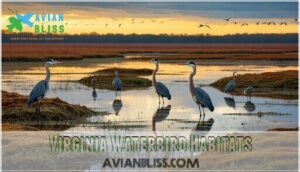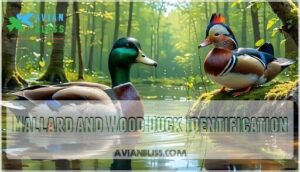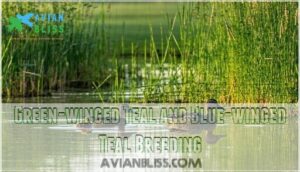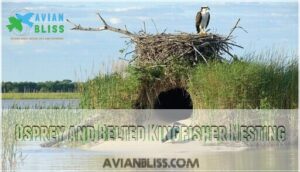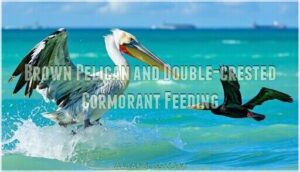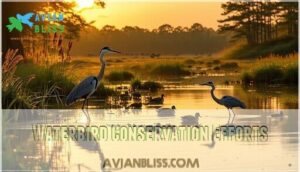This site is supported by our readers. We may earn a commission, at no cost to you, if you purchase through links.

The state’s location along the Atlantic Flyway brings incredible diversity—Great Blue Herons stalk through coastal marshes while Wood Ducks nest in swampy hollows.
Common species include Mallards, Canada Geese, and Double-crested Cormorants in freshwater areas, plus Brown Pelicans, Ospreys, and various sandpipers along the coast.
Winter brings Tundra Swans and diving ducks, while spring migration showcases colorful warblers and shorebirds.
Prime viewing spots include Back Bay National Wildlife Refuge, Great Dismal Swamp, and the Rappahannock River, where patient observers discover Virginia’s remarkable waterbird community thriving in carefully protected wetland ecosystems.
Table Of Contents
- Key Takeaways
- Water Birds Overview
- Virginia Waterbird Habitats
- Freshwater Bird Species
- Coastal Water Birds
- Waterbird Conservation Efforts
- Frequently Asked Questions (FAQs)
- What are the black waterbirds in Virginia?
- What is the white water bird in Virginia?
- Which birds stay around water?
- What diseases do Virginia water birds carry?
- When is best time for waterbird photography?
- How do water birds survive winter freezes?
- Which water birds are Virginia state symbols?
- What sounds do different waterbird species make?
- Conclusion
Key Takeaways
- You’ll find over 50 waterbird species across Virginia’s diverse aquatic habitats, from Chesapeake Bay’s coastal marshes to mountain streams, making it a premier destination for birdwatching
- Virginia’s position along the Atlantic Flyway brings incredible seasonal diversity – you’ll see resident species like Great Blue Herons and Wood Ducks year-round, plus winter visitors like Tundra Swans and migrating shorebirds in spring
- You can observe these birds in prime locations including Back Bay National Wildlife Refuge, Great Dismal Swamp, and the Rappahannock River, where over 100,000 acres have been restored through conservation programs
- You’ll help protect these waterbird populations by supporting wetland restoration, reducing water pollution from agricultural runoff and industrial discharge, and advocating for sustainable water management practices in your community
Water Birds Overview
Virginia’s waterways host over 50 species of water birds, ranging from familiar mallards and majestic great blue herons to elusive pied-billed grebes and soaring ospreys.
You’ll find these birds organized into distinct groups: dabbling and diving ducks, graceful geese and swans, long-legged wading birds like herons and egrets, plus specialized diving species such as loons and grebes that’ve mastered underwater hunting.
Ducks and Geese Species
Virginia’s diverse wetlands host over 30 duck and goose species, making waterfowl identification an exciting challenge for birdwatchers.
Virginia’s wetlands offer spectacular waterfowl diversity that challenges and rewards every birdwatcher.
These Virginia water birds showcase remarkable adaptability across freshwater and coastal habitats.
Key species you’ll encounter include:
- Mallards – Most abundant resident duck with distinctive green heads in males
- Canada Geese – Large, adaptable geese thriving in urban and wild settings
- Wood Ducks – Tree-nesting species with intricate plumage patterns
Waterfowl migration patterns bring seasonal visitors during spring and fall, while hybridization risks between mallards and black ducks complicate field identification.
Some species, like the American Wigeons, prefer quiet lakes.
Their wetland dependence highlights conservation needs.
Herons and Cranes Classification
You’ll find that heron taxonomy and crane phylogeny reveal fascinating differences despite their similar appearances.
Herons belong to Ardeidae family, while cranes are Gruidae members – completely different evolutionary histories.
Virginia water birds include fourteen heron species versus just one rare Sandhill Crane.
For species identification, watch flight patterns: herons retract necks, cranes stretch them.
Their habitat overlap creates confusion, but evolutionary history explains these Virginia wetlands birds’ distinct behaviors.
These birds show different flight characteristics, making them easy to distinguish.
Loons and Grebes Characteristics
You’ll recognize loons and grebes by their specialized diving adaptations – dense bones and rear-positioned legs that make them underwater champions but awkward on land.
These Virginia wetlands birds showcase distinct plumage variations, from loons’ checkered breeding patterns to grebes’ ornate head crests.
Their haunting vocalizations echo across Virginia bird habitats, while their floating nest behavior distinguishes them from other common Virginia birds.
These water birds primarily consume fish through their remarkable diving abilities. Many waterfowl possess waterproof feathering for insulation.
Virginia Waterbird Habitats
Waterbirds thrive across Virginia’s diverse aquatic landscapes, from the Chesapeake Bay‘s vast estuarine systems to mountain streams.
You’ll discover these feathered residents in coastal barrier islands, where Virginia’s Eastern Shore supports over 50% of all colonial waterbird breeding pairs.
Salt marshes along both bay shores provide critical stopover habitat for migrating species while filtering runoff and protecting coastlines from storm surges.
Freshwater wetlands inland offer breeding grounds for Great Blue Herons and Virginia Rails, who prefer areas with 40-70% emergent vegetation cover.
The state’s 21 Important Bird Areas span from sandy beaches to Appalachian peaks, showcasing remarkable habitat diversity. Many native species thrive in these varied locations.
However, these Virginia bird habitats face mounting challenges. Habitat Loss threatens coastal birds Virginia through development and sea-level rise, while Pollution Threats from pesticides and plastics impact water quality.
Climate Impacts intensify flooding and droughts, making Wetland Restoration and Conservation Strategies increasingly essential for protecting wading birds Virginia, seabirds Virginia, and other waterbirds.
Virginia birdwatching enthusiasts witness these changes firsthand.
Freshwater Bird Species
You’ll discover Virginia’s freshwater environments teeming with distinctive duck species, from the iconic green-headed mallards paddling in park ponds to the stunning wood ducks nesting in tree cavities along wooded streams.
These adaptable waterfowl showcase remarkable migration patterns and breeding behaviors that make them fascinating subjects for both casual observers and dedicated birders, highlighting their unique characteristics and breeding behaviors.
Mallard and Wood Duck Identification
You’ll spot mallards by their iridescent green heads and white neck rings on males, while females display mottled brown plumage.
Wood ducks showcase distinctive crested heads with striking white facial patterns on males.
Mallard characteristics include dabbling behavior in open water, contrasting with wood duck features like perching on branches.
Effective hunting involves decoys that mimic these birds.
These Virginia bird species prefer different habitats – mallards favor shallow ponds while wood ducks seek wooded swamps for Virginia birdwatching enthusiasts, which involves effective hunting.
American Wigeon and Northern Pintail Migration
During peak migration seasons, you’ll witness American wigeons and northern pintails transforming Virginia’s wetlands into bustling stopovers.
These Virginia bird species follow distinct migration patterns—wigeons arriving by late fall from northern breeding grounds, while pintails begin their journey as early as August.
Wigeons need specific sustenance, so consider their preferred food sources during migration.
Climate impacts and habitat loss increasingly challenge these freshwater resources, affecting wigeon diet availability and pintail breeding success across Virginia wildlife corridors.
Green-winged Teal and Blue-winged Teal Breeding
Teal species in Virginia showcase distinct Teal Breeding Success patterns across freshwater resources.
Blue-winged teals arrive earlier for spring nesting, while green-winged teals prefer later breeding seasons.
Understanding their Teal Habitat Selection helps with Virginia bird guide identification:
- Nest timing: Blue-winged teals nest April-May, green-winged teals prefer May-June
- Teal Nesting Habits: Both species choose shallow wetland edges with dense vegetation
- Teal Duckling Survival: Broods remain near nesting areas for 6-7 weeks
- Teal Migration Patterns: Green-winged teals winter locally, blue-winged teals migrate south
Coastal Water Birds
You’ll discover Virginia’s coastal waters teem with magnificent birds perfectly adapted to saltwater environments and tidal marshes.
From the massive Brown Pelicans diving for fish to the sleek Ospreys building platform nests, these species showcase remarkable feeding strategies and nesting behaviors that make coastal birdwatching an unforgettable experience.
Sandhill Crane and White Ibis Conservation
Two remarkable success stories highlight Virginia’s conservation achievements.
White Ibis populations exploded from under 400 pairs in 2013 to over 1,500 by 2018, while Sandhill Cranes recovered from near-extinction east of the Mississippi.
Wetland Restoration and targeted Conservation Strategies address Ibis Threats like habitat loss and pollution.
These Population Trends reflect effective bird conservation Virginia efforts, making both species increasingly common on your Virginia bird checklist as rare birds Virginia become established residents, thanks to successful conservation.
Osprey and Belted Kingfisher Nesting
Observing Osprey Nesting Habits reveals these magnificent raptors construct massive stick platforms atop dead trees near Virginia’s water bodies.
You’ll find Belted Kingfishers excavating tunnel burrows in riverbanks, creating three-foot-deep chambers.
Both species show remarkable Habitat Overlap around Chesapeake Bay’s ecosystems, though Nesting Competition remains minimal due to different site preferences.
Consider installing an osprey nesting platform to support local populations, which benefits from improved water quality at birding hotspots Virginia offers photographers, ultimately affecting their Conservation Status and supporting local populations.
Brown Pelican and Double-crested Cormorant Feeding
You’ll witness spectacular feeding displays when Brown Pelicans and Double-crested Cormorants hunt Virginia’s coastal waters. These skilled predators employ different strategies that showcase nature’s ingenuity.
Key Feeding Behaviors:
- Brown Pelicans execute dramatic plunge dives from 20-60 feet high
- Cormorants pursue fish underwater using powerful webbed feet for propulsion
- Both species target similar prey, creating natural competition in ecosystems
- Cooperative fishing occurs when multiple birds work together at birding hotspots Virginia
Brown Pelicans demonstrate remarkable Pelican Feeding Habits by spotting fish from above, then folding their wings for precision strikes. Their expandable throat pouches drain water before swallowing prey.
Meanwhile, cormorants showcase their Cormorant Diet preferences through underwater pursuit, remaining submerged for up to 70 seconds. These birds face population management issues due to booming population numbers.
This Prey Competition shapes local Seabird Food Webs, especially around productive water bodies where both species concentrate. Watch for Cooperative Fishing events at popular shorebirds Virginia locations, perfect opportunities for bird photography Virginia enthusiasts.
Waterbird Conservation Efforts
You can help protect Virginia’s waterbirds by supporting wetland conservation programs and advocating for cleaner waterways in your community.
These conservation efforts focus on three key areas: preserving critical wetland habitats, reducing harmful water pollution, and promoting sustainable water management practices that benefit both birds and people.
Protecting Wetland Habitats
Virginia’s habitat restoration programs have transformed waterbird conservation, with over 100,000 acres benefiting from strategic initiatives.
You’ll find these efforts particularly effective in reversing population declines through targeted wetland restoration and invasive species management.
| Conservation Strategy | Impact on Water Ecosystems |
|---|---|
| Habitat Partners Program | Encourages private landowner participation in wetland habitats creation |
| Important Bird Areas (IBAs) | Designates priority locations for shorebirds Virginia conservation |
| Social Attraction Systems | Audio lures support bird migration Virginia in restored sites |
| Climate Change Adaptation | Addresses sea level rise threats to water quality stability |
These conservation policies create resilient networks supporting diverse waterbird populations across Virginia’s landscapes.
Reducing Water Pollution
Water pollution threatens Virginia’s waterbirds through multiple pathways.
Mercury contamination from Industrial Discharge creates toxin levels ten times higher than normal in mallards and wood ducks. Lead poisoning from hunting pellets causes annual Wastewater Treatment challenges in estuaries.
Agricultural Runoff disrupts food webs through nutrient pollution in Chesapeake Bay.
Conservation Strategies include riparian buffers and water quality programs that protect water ecosystems while improving water management across Virginia’s waterways.
Promoting Sustainable Water Management
Beyond pollution control, you can support Virginia’s waterbirds through thorough water management strategies.
The state’s Wetland Program Plan emphasizes monitoring, regulation, and voluntary restoration to achieve no-net-loss goals.
Water conservation and wastewater recycling initiatives protect aquatic ecosystems that sustain migratory populations.
Public-private partnerships enable sustainable water technologies, while multi-stakeholder collaboration addresses climate change impacts on habitat stability.
These efforts align with national conservation initiatives aimed at protecting bird habitats.
Frequently Asked Questions (FAQs)
What are the black waterbirds in Virginia?
You’ll spot several black waterbirds across Virginia’s wetlands and waterways. Common grackles, red-winged blackbirds, and American coots frequent marshes, while double-crested cormorants and anhinga plunge into deeper waters for fish.
What is the white water bird in Virginia?
A penny for your thoughts on Virginia’s white waterbirds! You’ll typically spot Great Egrets, their snowy plumage and yellow bills making them unmistakable along marshes and waterways throughout the state.
Which birds stay around water?
You’ll find herons, egrets, ducks, geese, and kingfishers hanging around water year-round. These birds depend on aquatic habitats for food, nesting, and shelter, making wetlands their permanent home base.
What diseases do Virginia water birds carry?
Picture waterfowl gliding gracefully across Virginia’s lakes—you’re watching potential carriers of avian influenza , West Nile virus, and various parasites that could pose health risks to humans and other animals.
When is best time for waterbird photography?
Early morning and late afternoon provide ideal lighting conditions for waterbird photography.
You’ll capture stunning shots when birds are most active during feeding times, typically within two hours of sunrise and sunset when golden light enhances feather details beautifully.
How do water birds survive winter freezes?
Water birds adapt through several key strategies: they’ll migrate to warmer regions, huddle together for warmth, fluff their feathers for insulation, and rely on fat reserves.
You’ll spot them seeking unfrozen water sources like moving streams or heated areas near buildings, which helps them survive during colder periods, and this behavior is crucial for their adaptation.
Which water birds are Virginia state symbols?
Seven states share the Northern Cardinal as their state bird, making it America’s most popular official avian symbol.
Virginia’s only official state bird is the Northern Cardinal, designated in
No water birds hold official state symbol status in Virginia.
What sounds do different waterbird species make?
You’ll hear Great Blue Herons make harsh croaking sounds, while Mallards offer familiar quacks.
Geese honk loudly, especially during migration.
Wood Ducks produce distinctive squealing calls, and Ospreys create sharp whistling sounds when hunting or communicating with their mates.
Conclusion
Virginia’s waterbird diversity is absolutely staggering—you’ll discover an incredible living laboratory spanning coastal marshes to mountain streams.
These water birds in Virginia demonstrate nature’s remarkable adaptability across diverse ecosystems.
You’ve learned about 50+ species thriving in carefully managed habitats, from migrating Tundra Swans to nesting Brown Pelicans.
Your conservation efforts directly impact these populations’ survival.
By protecting wetlands, reducing pollution, and supporting sustainable water management, you’re ensuring future generations can witness Virginia’s extraordinary waterbird communities flourishing throughout the Commonwealth’s precious aquatic environments, which is a truly remarkable outcome.
- https://en.wikipedia.org/wiki/List_of_birds_of_Virginia
- https://www.chesapeakebay.net/discover/field-guide/critters?fieldGuideType=Wading+Birds
- http://www.pwconserve.org/wildlife/birds/index.html
- https://www.dcr.virginia.gov/insights/where-to-find-the-best-birding-in-virginia
- https://visitvirginia.guide/fall-bird-migration-in-virginia/

